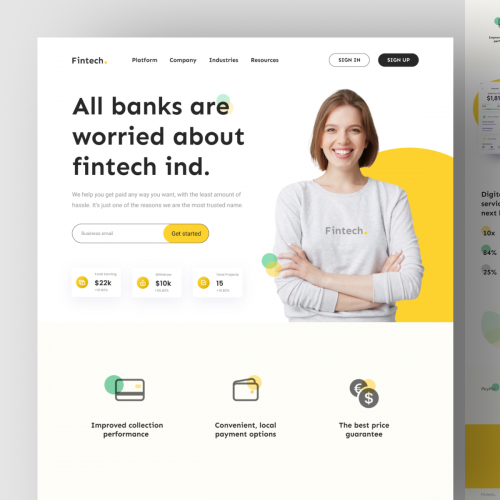Responsive Website Design Services to Enhance Your Business
Responsive Website Design Services to Enhance Your Business
Blog Article
Top Tips for Producing an Impactful Internet Site Design That Converts
To attain this, one have to think about a range of factors, consisting of comprehending the target audience, prioritizing user experience, and maximizing for mobile platforms. The strategic usage of compelling call-to-actions and a well-defined aesthetic power structure plays a critical function in guiding customers with their journey.

Understand Your Target Market
Recognizing your target market is fundamental to reliable web site style, as it prepares for developing an appealing user experience. Recognizing who your users are, including their demographics, choices, and habits, enables developers to tailor the website's web content, layout, and capability to satisfy certain needs.
Performing complete market research study is essential in this procedure. Surveys, meetings, and analytics can provide useful insights into customer expectations and pain points. By assembling this data, designers can develop user characters that represent different sectors of the audience, making certain that design choices are educated and relevant.
Moreover, recognizing the target audience assists in picking suitable style components such as color design, typography, and images that reverberate with users. A web site that talks directly to its audience promotes a feeling of connection and count on, urging longer visits and higher conversion rates.
Inevitably, a user-centered approach to site style not just boosts customer complete satisfaction yet also supports company goals by driving involvement and commitment. By focusing on the needs and preferences of the target audience, a site can properly offer its objective and attain desired results.
Prioritize Customer Experience
To boost the total effectiveness of a website, prioritizing individual experience (UX) is essential (Website Design). A well-designed UX guarantees that visitors can navigate the site easily, locate information promptly, and engage with material meaningfully. This results in increased individual contentment and higher conversion rates
Begin by applying intuitive navigating. Menus needs to be practically structured, permitting users to situate vital locations of the site with very little effort. Consistency in style elements, such as color pattern and typefaces, promotes knowledge, which is critical for maintaining individual involvement.
Furthermore, think about the loading speed of your site. A delay of just a few seconds can cause substantial drop-offs, as individuals are much less most likely to wait on a slow-loading page. Streamlining images and enhancing code can improve efficiency and preserve site visitors.
By focusing on customer experience, you not only create a more pleasurable environment for site visitors but also enhance your brand name's reputation. Inevitably, a focus on UX is a financial investment in the long-lasting success of your site.
Optimize for Mobile Tools
Optimizing for mobile phones is essential in today's electronic landscape, where an enhancing variety of users accessibility web sites through smartphones and tablets. A mobile-friendly layout not just boosts customer experience however likewise plays a substantial role in enhancing internet search engine positions. To achieve this, it is necessary to embrace a receptive style that instantly readjusts to different display sizes and alignments.

Packing speed is an additional critical aspect; mobile individuals are typically less person and anticipate fast accessibility to info. By focusing on mobile optimization, you make sure that your internet site stays affordable and properly engages a more comprehensive target market.
Use Compelling Call-to-Actions
An internet site's efficiency typically pivots on its capacity to guide site visitors towards desired actions, making engaging call-to-actions (CTAs) important parts of design. CTAs serve as the pivotal points that guide individuals to involve with the website, whether that implies buying, enrolling in a newsletter, or downloading a resource.
To produce efficient CTAs, quality is critical. Use succinct language that clearly interacts the action you want the user to take. Phrases such as "Begin," "Register Free," or "Shop Now" not only communicate seriousness but additionally remove uncertainty. The positioning of CTAs he has a good point is similarly essential; they should be purposefully positioned throughout the page to ensure they are easily noticeable, specifically in high-traffic areas.
Furthermore, the style of CTAs must attract attention without being noticeable. Employ contrasting shades and clear font styles to guarantee they capture interest. Additionally, take into consideration using directional hints, such as arrowheads or photos, to assist customers toward these switches. By concentrating on these components, companies can dramatically enhance user engagement, driving conversions and inevitably attaining their web site's objectives.
Emphasis on Visual Power Structure
Reliable web site layout counts heavily on a well-structured aesthetic hierarchy that guides users via material effortlessly. By arranging aspects in a manner that prioritizes info, developers can boost user experience and promote decision-making. This entails making use of dimension, color, contrast, and spacing strategically to accentuate the most vital parts of a page.
The use of bigger typefaces for headings and subheadings establishes a clear distinction in between different areas, permitting individuals to check material easily. Furthermore, using different colors for buttons and calls-to-action can capture customer interest and urge communication. Whitespace is one more vital element; it stops clutter and enables individuals to concentrate on key messages without interruptions.
Pictures and graphics must match the message while likewise adhering to the established power structure, reinforcing the general message (Website Design). Consistency in style aspects, such as the original source color pattern and typography, further enhances the aesthetic power structure, making navigating instinctive

Conclusion
In final thought, efficient site style requires a thorough understanding of the target audience, prioritization of individual experience, and mobile optimization. Inevitably, a well-executed internet site design serves as a vital component in driving individual actions and achieving service objectives.
Report this page